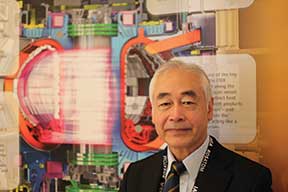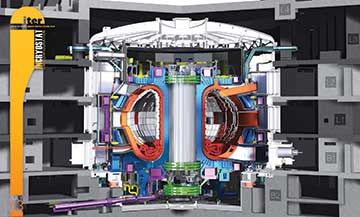Pallava Bagla
A star is set to be born in southern France. A humongous effort costing over $ 20 billion is being made to construct a nuclear reactor like never before, a special steel cauldron where fusion energy could be tapped; it is called the International Thermonuclear Experimental Reactor (ITER). Ratan Kumar Sinha, Chairman of the Atomic Energy Commission told NDTV, “Fusion energy holds the promise of becoming an unlimited source of environment friendly energy for the world.”

The reactor will weigh about 23,000 tons, the equivalent of the weight of three Eiffel Towers. Some 80,000 kilometres of special super conducting wires will be used.
Six nations – India, China, South Korea, USA, Japan, Russia, and the European Union have joined hands as equal partners to see if they can jointly harness the power of the sun by literally confining it in a steel bottle. According to the head of ITER, Dr. Osamu Motojima, together these entities “represent half the world’s population and account for two-third of the global economic might” so according to him the best chance of harnessing fusion power is at ITER.
Todays’ atomic power plants generate power by splitting the atoms and in doing so they produce large quantities of radioactive waste that can be dangerous for hundreds of years and therefore has to be handled with extreme care. In contrast `fusion energy’ generates power by joining two atoms into one, the usual raw material is hydrogen and the largest amount of waste generated can be either helium, a benign noble gas or at worst, water, so sometimes this is referred as ‘evergreen atomic energy’. According to Dr. Ravi Grover, head of the Indian delegation at ITER, “Fusion is inherently safe, there is no danger of an uncontrolled chain reaction and fears of a nuclear explosion are negligible, producing almost no long lived radioactive waste.”
Within the massive steel frame, gas will be heated to over 150 million degrees temperature and it will be confined into a limited space using giant magnets, some atoms will then fuse together releasing huge amounts of heat which can then be directed to run turbines to generate electricity. In the first instance, it is hoped the fusion reactor will produce 10 times more energy than what is used to initiate the reaction estimated to produce the equivalent of 500 MW of power.

Recently, some 800 of the best brains in the world from more than 35 countries gathered to take stock of fusion energy at the International Conference on Thermonuclear Fusion Energy held from October 13-18, 2014 at the picturesque town of Saint Petersburg, Russia. The mood was generally upbeat but there are worries that cost and time over runs could spiral out of control in this mammoth exercise. Motojima admits there have been ‘delays’ and hopes by next year, his team will be able to give a firm schedule on when ITER could be completed.
The delay has already spooked the USA which is threatening to pull out of the global project. On being asked about this, Motojima said, ‘I have the confidence the US will never drop out of ITER’ since according to him ‘the fusion reactor has already passed the point of no-return.’ The Russians, who through their state owned nuclear company Rosatom are really spearheading the project seem less concerned. Vyacheslav Pershukov, Deputy Director General, Rosatom State Corporation said ‘any country can be replaced since the domain knowledge rests with many partner countries.’

India is a full member of this enterprise, providing about 10 percent of the components for the massive nuclear complex that is unfolding at Cadarache in France. New Delhi is contributing to what will be the world’s largest refrigerator when it is completed in 2021. It also acts like a thermos flask but operates at some of the coldest temperatures ever seen in the universe, working at minus 269 degrees Celsius and technically called a ‘cryostat’. It is being made to order for the Department of Atomic Energy by L&T Industries. M V Kotwal, President, Heavy Engineering L&T industries, Mumbai says, ‘Manufacture and installation of the cryostat has been entrusted to L&T. Work on this project is already in progress in our Hazira manufacturing complex. We have also constructed a special workshop at the site in Cadarache, France, to enable site assembly of the large and complex stainless steel structure from components which will be supplied from Hazira in India.’
India will make in-kind investment probably totalling about Rs 9000 crores over the next decade thus contributing about 9.1 percent of the share of the total costs.
Motojima says he is ‘happy with India’s on-schedule and within budget robust contribution’ and adds that in return in the long run ‘India will get access to 100 percent of the intellectual property that goes into the making of the ITER’.
Sinha says, “Participation of India in the ITER project, with its immense scientific talent and industrial competence, has provided an opportunity to India to master the cutting edge technologies manifest in this massive project. In the near term, it has facilitated a huge impetus to scientific research, manpower development and building an internationally competitive industrial capability within the Indian private sector in the highly advanced field of fusion energy.”
Once the proof is established that mankind can harness the power of the sun, India could well build its own fusion reactors possibly very soon after 2050, thus providing unlimited energy.
Copyright: Pallava Bagla, 2015
(A version of this write-up appeared on www.ndtv.com on October 28, 2014)
Points for Discussion
Why are scientists looking for different forms of energy? What could this experiment mean for the world?
What is the fuel that is responsible for the sun’s energy? Or how does the sun generate energy?
How is this fusion different from nuclear fission?
Find out how much power a fusion reactor will be able to deliver and at what cost?
The author is Science Editor for NDTV. He can be reached at pallava.bagla@gmail.com. Twitter handle: @pallavabagla
